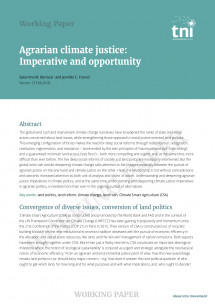Agrarian climate justice: Imperative and opportunity
Global pressure on land and natural resources is mounting, with mainstream narratives about climate change often intensifying pressure to replace so-called "inefficient" users of land, including small farmers and pastoralists with market-based dynamics and actors. This dynamic makes the pursuit of socially just land policy ever more important and urgent, while at the same time creating new challenges. The fundamental connections and tensions between agrarian and climate justice must be reckoned with, and movements on both sides must deepen their understanding.

Authors
Abstract
The global land rush and mainstream climate change narratives have broadened the ranks of state and social actors concerned about land issues, while strengthening those opposed to social justice-oriented land policies. This emerging configuration of forces makes the need for deep social reforms through redistribution, recognition, restitution, regeneration, and resistance -- book-ended by the twin principles of ‘maximum land size’ (‘size ceiling’) and a ‘guaranteed minimum land access (‘size floor’) – both more compelling and urgent, and, at the same time, more difficult than ever before. The five deep social reforms of socially just land policy are necessarily intertwined. But the global land rush amidst deepening climate change calls attention to the linkages especially between the pursuit of agrarian justice on the one hand and climate justice on the other. Here, the relationship is not without contradictions and warrants increased attention as both unit of analysis and object of action. Understanding and deepening agrarian justice imperatives in climate politics, and at the same time, understanding and deepening climate justice imperatives in agrarian politics, is needed more than ever in the ongoing pursuit of alternatives.
